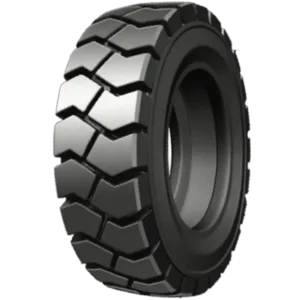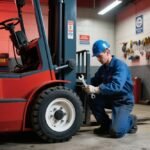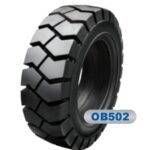The frustration with flat tires is universal, and it seems like solid tires would be the obvious solution. They do exist, but they aren’t common for most vehicles (like cars, bikes, or motorcycles) due to significant drawbacks that outweigh the benefit of no flats.
Here’s why solid tires aren’t the mainstream solution:
- Horrible Ride Quality (Comfort):
- Air is the Ultimate Shock Absorber: The air chamber in pneumatic tires compresses to absorb bumps and road imperfections, providing a smooth ride for passengers and protecting the vehicle’s suspension and cargo.
- Solids Transmit Shock: A solid tire is inherently rigid. Every bump, crack, or pebble is transmitted directly through the tire into the wheel, suspension, chassis, and ultimately the occupants. This creates a harsh, jarring, and uncomfortable ride, especially at higher speeds.
- Poor Handling and Traction:
- Flexibility is Key for Grip: Pneumatic tires flex and deform slightly as they contact the road, increasing the contact patch and providing crucial grip, especially during cornering, braking, and acceleration.
- Solids Lack Conformity: Solid tires are much stiffer. They don’t conform to the road surface effectively. This leads to significantly reduced traction, particularly on wet, icy, or uneven surfaces, resulting in longer stopping distances, poorer cornering ability, and increased risk of skidding.
- Excessive Weight:
- Air is Light: The air in a pneumatic tire contributes almost nothing to its weight.
- Rubber is Heavy: Solid tires are made entirely of dense rubber or composite materials. This adds significant unsprung weight (weight not supported by the suspension).
- Consequences: Increased weight hurts fuel efficiency (or battery range in EVs), reduces acceleration, increases braking distances, and puts more stress on suspension components, leading to faster wear and tear.
- Heat Buildup (Critical at Speed):
- Flexing Generates Heat: As a tire rolls, its material constantly flexes and deforms. This internal friction generates heat.
- Air Dissipates Heat: Pneumatic tires use the circulating air inside to help dissipate this heat effectively.
- Solids Overheat: Solid tires have no internal airflow. The heat generated by constant flexing has difficulty escaping, especially at higher speeds. This heat buildup can degrade the rubber compound rapidly, leading to premature failure, blowouts, or even fires. This is the primary reason they are unsafe for highway speeds.
- Increased Rolling Resistance:
- The constant, larger deformation of the solid material as it rolls creates significantly more rolling resistance than a pneumatic tire. This directly translates to worse fuel economy or reduced battery range.
- Cost and Complexity:
- Solid tires often require more material and specialized molds/manufacturing processes, sometimes making them more expensive than comparable pneumatic tires.
- Mounting solid tires onto wheels is often more complex and requires specialized presses due to their rigidity.
Where Solid Tires Are Used:
Because they eliminate flats and punctures, solid tires excel in specific, low-speed applications where the drawbacks are manageable or even beneficial:
- Forklifts & Industrial Equipment: Stability is paramount, speeds are low (<10 mph), and punctures from debris on warehouse floors are a major operational hazard and cost.
- Lawn Mowers & Yard Equipment: Low speeds, puncture resistance from sticks/thorns is valuable, ride comfort is less critical.
- Golf Carts: Low speeds on relatively smooth paths.
- Wheelbarrows: Simple, low-speed, puncture-proof solution.
- Certain Construction/Utility Vehicles: Where puncture resistance in harsh environments is the top priority.
The Future: Non-Pneumatic Tires (NPTs) / Airless Tires:
Technology is evolving! Companies (like Michelin with their Uptis prototype) are developing advanced “Airless” or Non-Pneumatic Tires (NPTs). These aim to solve the puncture problem without the traditional solid tire drawbacks:
- Flexible Structures: They use sophisticated, open-cellular structures (often plastic/composite) instead of solid rubber. This structure provides:
- Shock Absorption: The structure itself deforms to absorb bumps.
- Cooling: Open design allows air flow for heat dissipation.
- Reduced Weight: Lighter than solid rubber tires.
- Conformity: Designed to flex for better traction than solids.
- Goal: Offer the puncture-proof benefit while approaching the comfort, handling, and efficiency of pneumatic tires.
Related Product
-
 6.00-9/4.00 tyres OB502 Pattern Solid Forklift Tyres by Advance Brand
6.00-9/4.00 tyres OB502 Pattern Solid Forklift Tyres by Advance Brand -
 Advance Brand High Quality Solid Tires 18×7-8/4.33 with OB502 Pattern ForkLift Tire
Advance Brand High Quality Solid Tires 18×7-8/4.33 with OB502 Pattern ForkLift Tire -
 High Quality Advance Solid Tires 5.00-8/3.00 with OB502 Pattern for Diesel ForkLift
High Quality Advance Solid Tires 5.00-8/3.00 with OB502 Pattern for Diesel ForkLift -
 Advance Solid Tires 4.00-8/3.00 with OB502 Pattern for Diesel ForkLift
Advance Solid Tires 4.00-8/3.00 with OB502 Pattern for Diesel ForkLift




